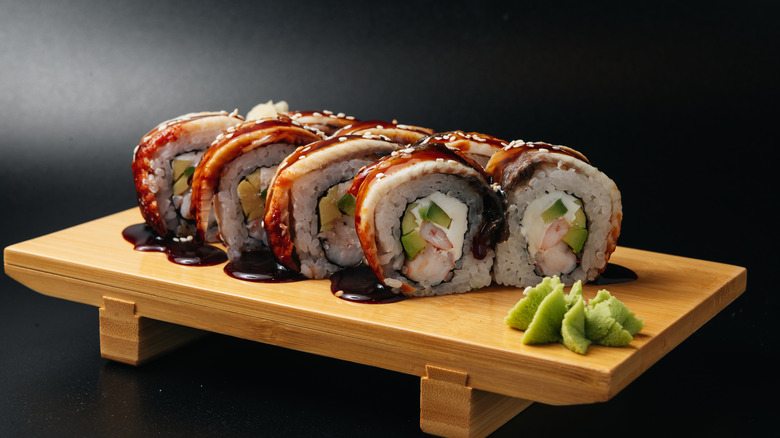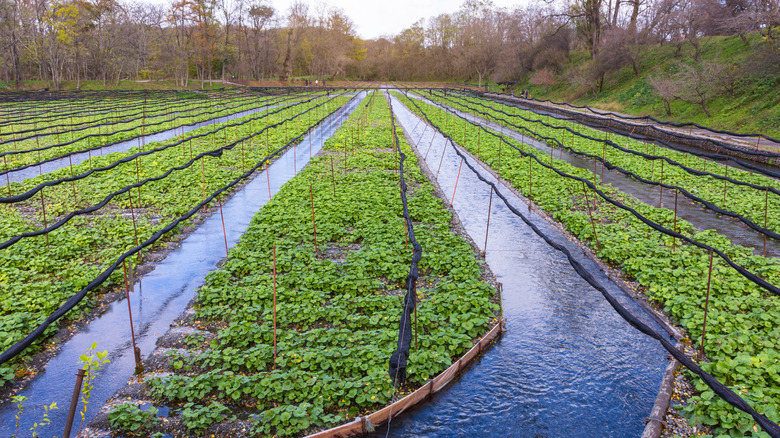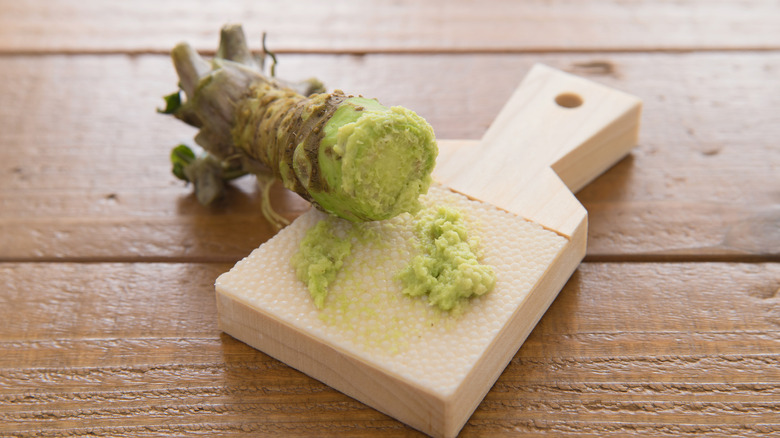You Only Have About 15 Minutes To Enjoy Real Wasabi. Here's Why
Sushi has taken America by storm in the past few decades, rising from an exclusively West Coast phenomenon to a staple meal of the American diet in less than 40 years and reshaping entire local economies in the process. And, while there are many aspects to a great sushi dinner, no matter what you order, every meal features two side ingredients: pickled ginger, used to cleanse the palate, and the ever-spicy lump of green paste you know as wasabi.
But the weird thing is ... you've probably never tasted real wasabi. Don't feel bad about that; most people haven't, even those who've been enjoying sushi for decades. But a variety of factors combine to make eating actual wasabi not just rare, but not even necessarily desirable. One of the key ones is timing: Once prepared, wasabi stays fresh for the culinary equivalent of a chemically-produced element with a half-life measured in seconds. You've only got about 15 minutes to enjoy it.
Wasabi does not last long at all
The biggest problem with wasabi is it's unbelievably difficult to cultivate, on par with something like saffron. In order to grow wasabi, water must be run over the plant's rhizomes (the stems, which are the actual product) at a gentle pace for literally years. It's also incredibly picky about other growing conditions, only germinating at temperatures between 46 and 70 degrees Fahrenheit in a narrow range of humidity. Even most parts of Japan aren't suitable for wasabi cultivation; the majority of it comes from Nagano prefecture, which contains the world's largest commercial wasabi farm.
And while it might be tasty, you have to enjoy it fast. Thanks to oxygen and moisture in the air, grated fresh wasabi rhizome loses its flavor in around a quarter of an hour. It doesn't become totally tasteless or anything, but it loses a lot of the pungency, aroma, and kick that makes it so special. Few foods find their flavor half-life expiring so quickly.
All of this combined explains why chefs in America (and even a lot of them in Japan) prefer wasabi substitutes, typically a mashed-up mixture of horseradish, Chinese mustard, starch, and green food coloring. While it may not have the flavor complexity of wasabi and the texture is somewhat different, it approximates the taste pretty well — and is far, far less of a logistical headache.
Wasabi has a long history in Japanese food
Despite the difficulties in growing and serving it, wasabi has been a part of Japanese cuisine for a long, long time. Its earliest uses were medicinal, but records of it as a food date from the 8th century A.D. during the Nara period, when a Buddhist monk named Kohbou-Daishi in Mie prefecture (south of Nagano, but still in the central Honshu area where wasabi grows best) transplanted wild wasabi to the area around the Chuzen-ji Temple where he lived.
It wasn't until much more recently that it was used in the modern fashion, however. Wasabi became a prized possession among the samurai caste in part due to one very, very important person from Japanese history: Tokugawa Ieyasu. The founder of the Tokugawa Shogunate, Ieyasu is one of the towering figures in Japanese history, the man who essentially ended the Sengoku Era (1467-1615). In addition to being one of the most famous samurai in history, Ieyasu was also his day's equivalent of a foodie and developed a particular love for wasabi. During and after his rise to power, many other samurai lords looked to curry his favor and ape his preferences (he was even presented with an entire cultivar of wasabi upon his retirement from the shogunate in 1607), and wasabi's widespread popularity caught on from there.


